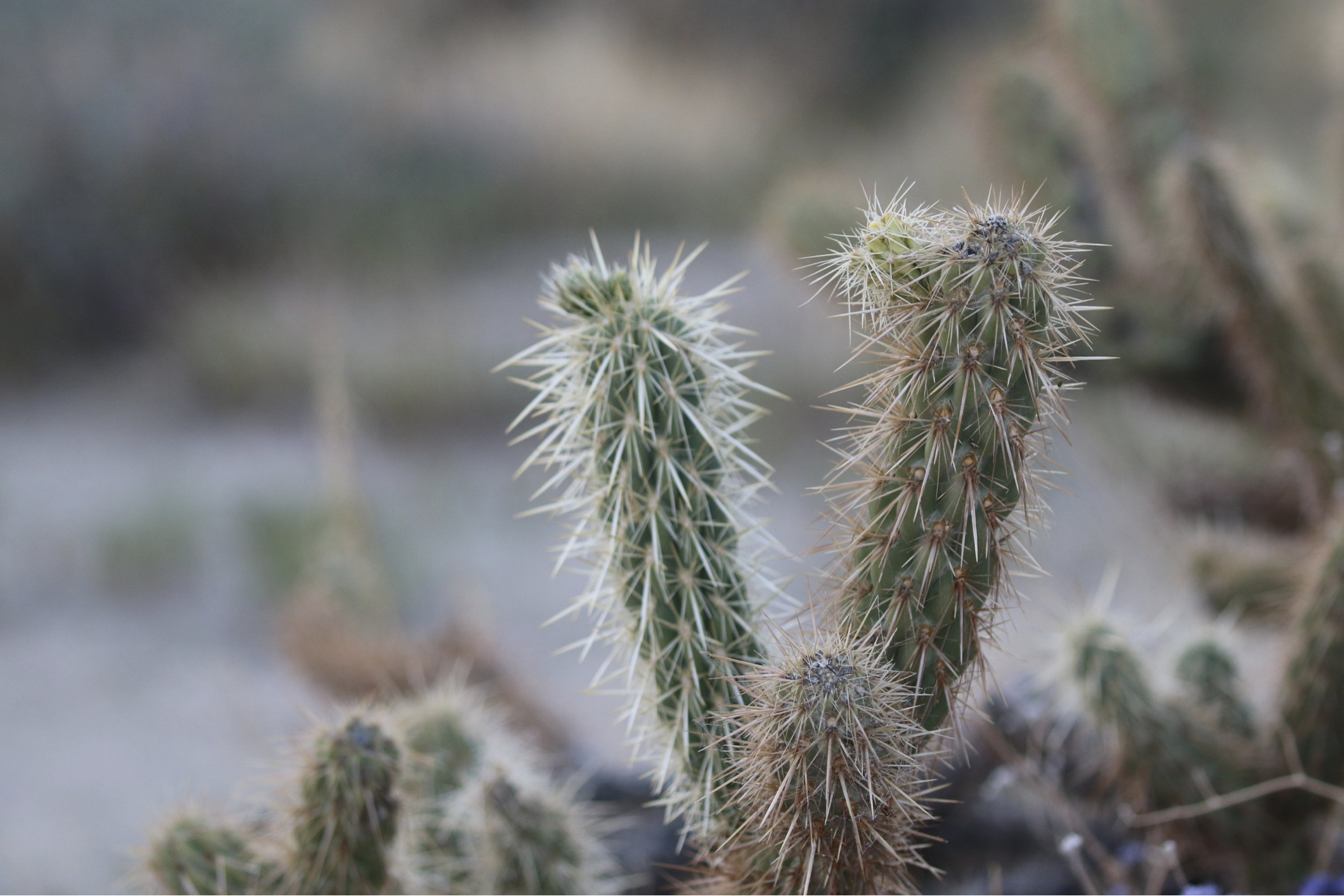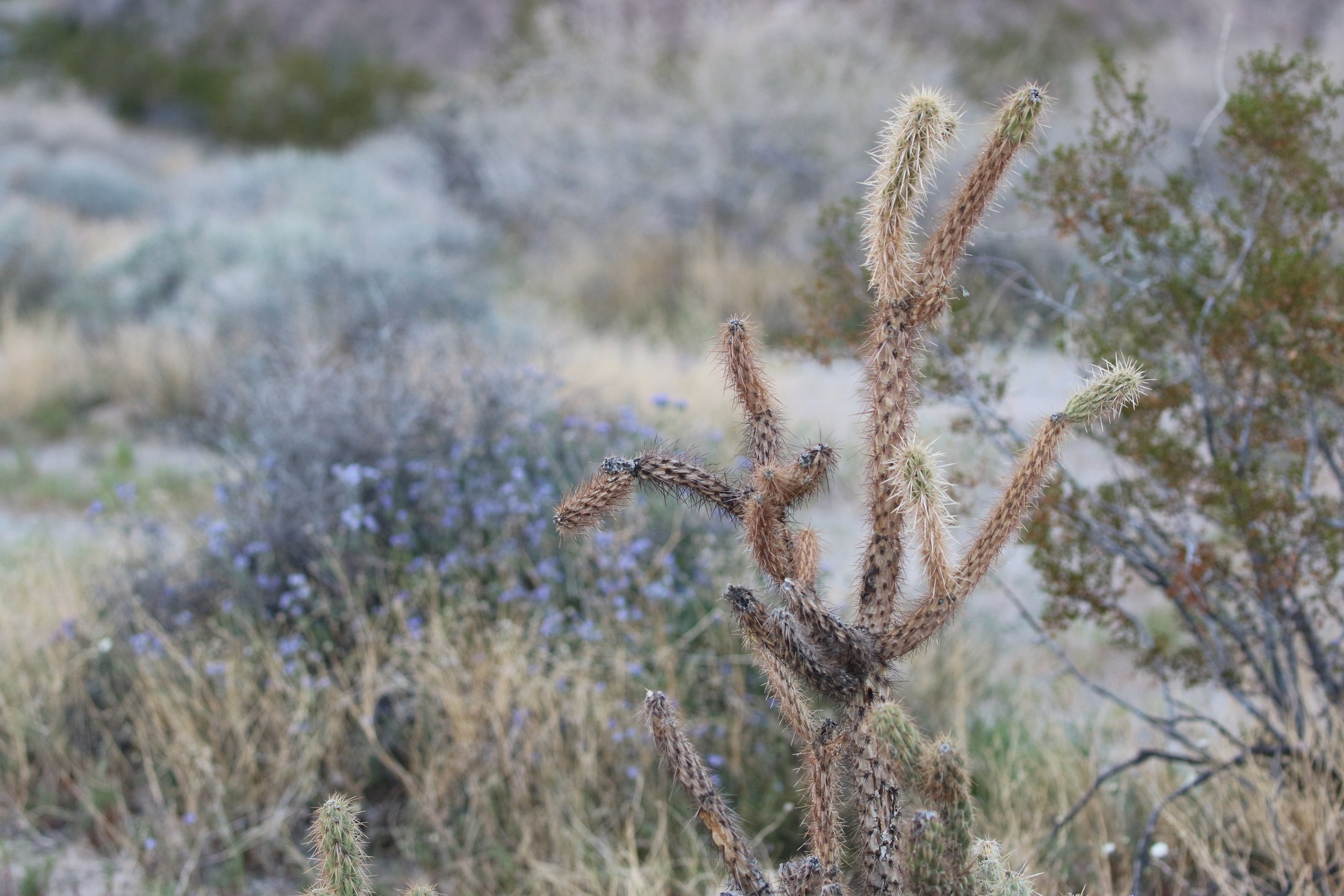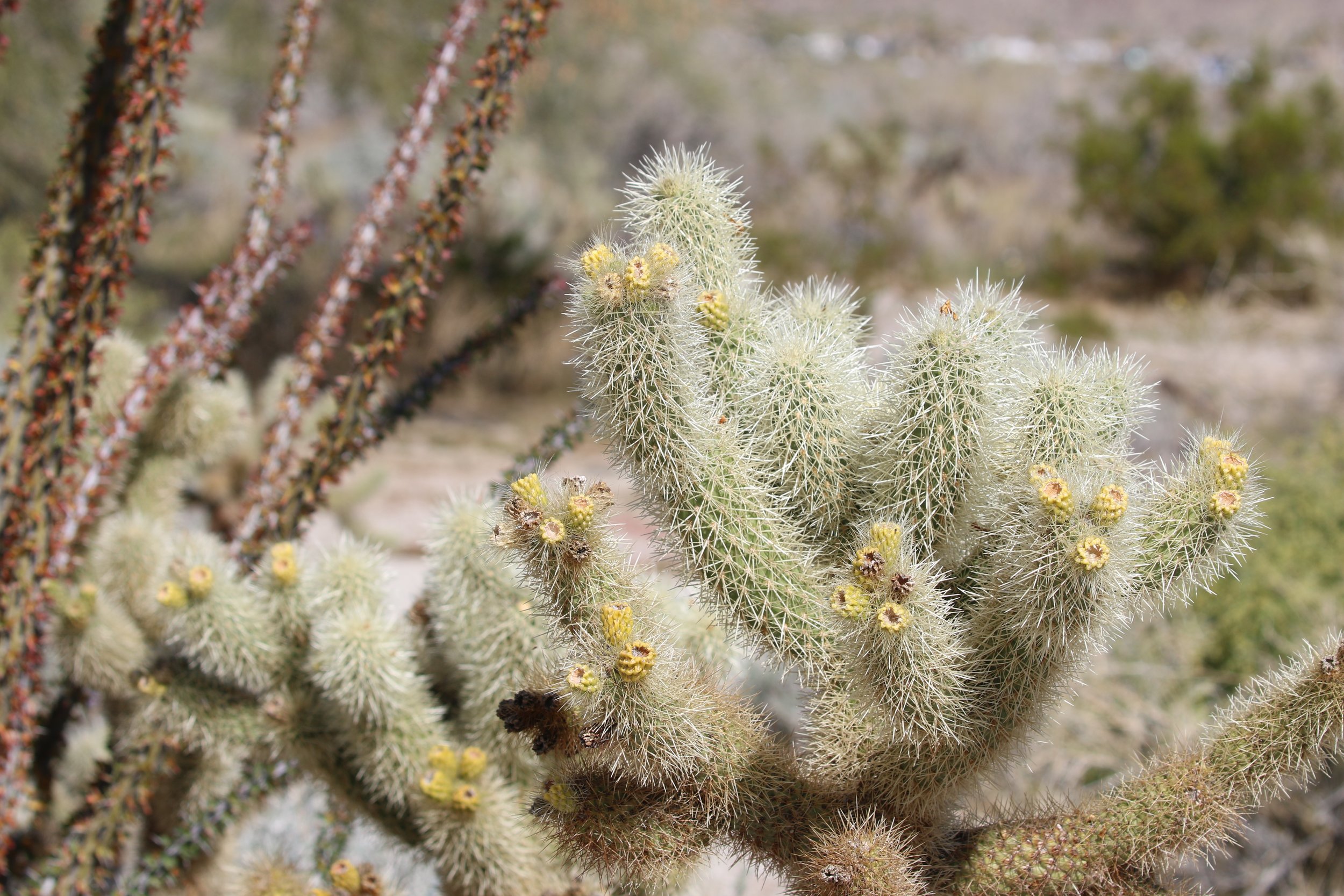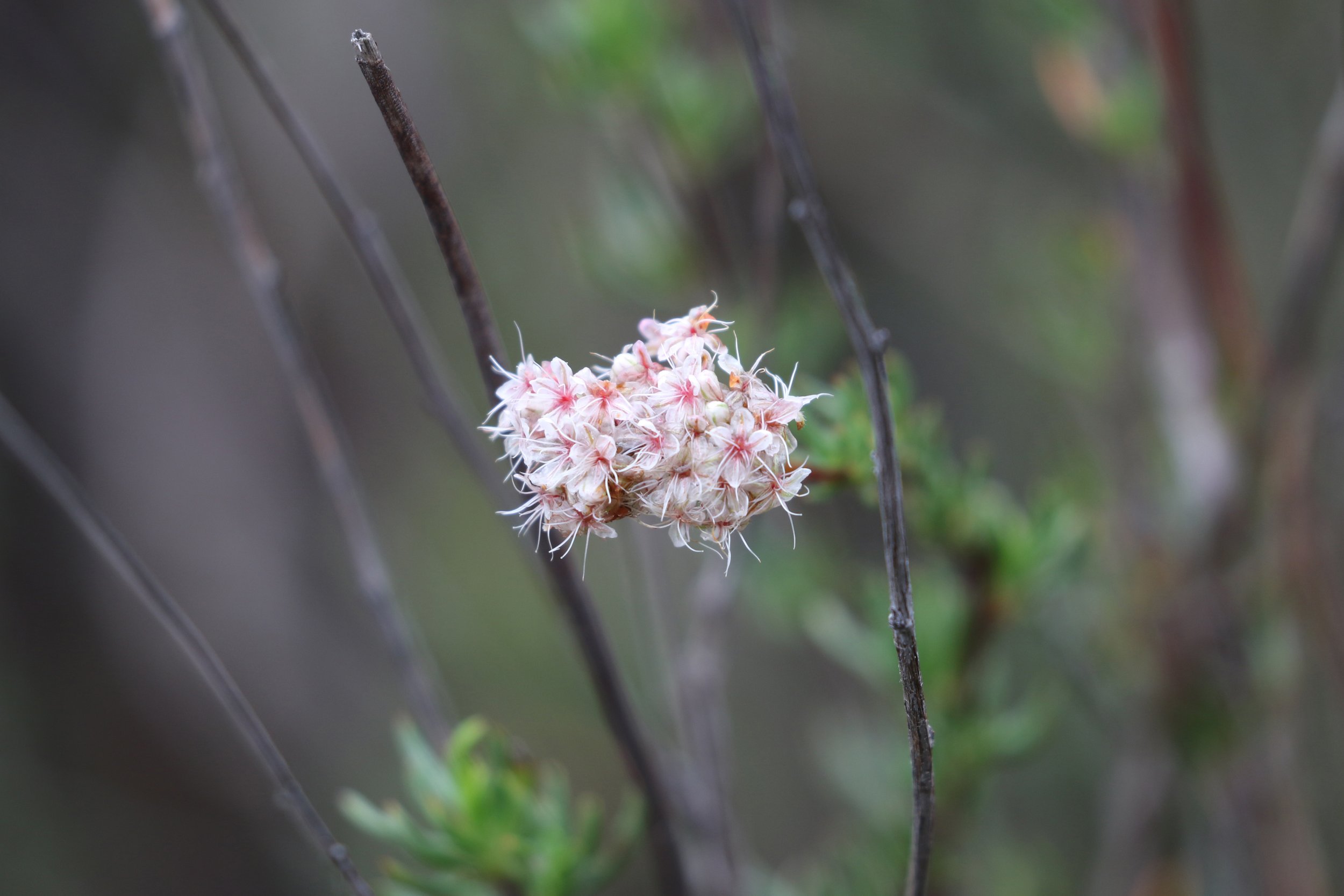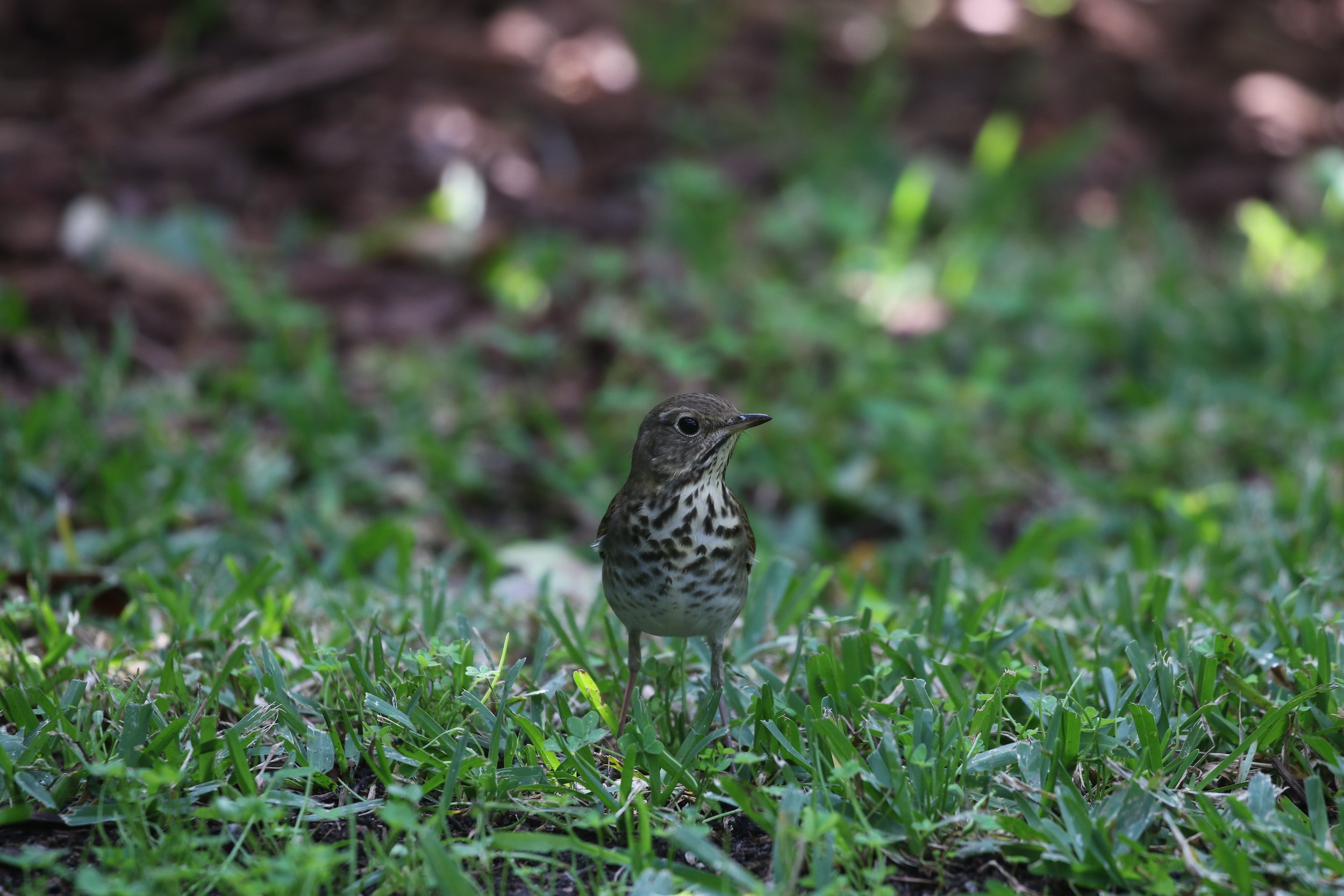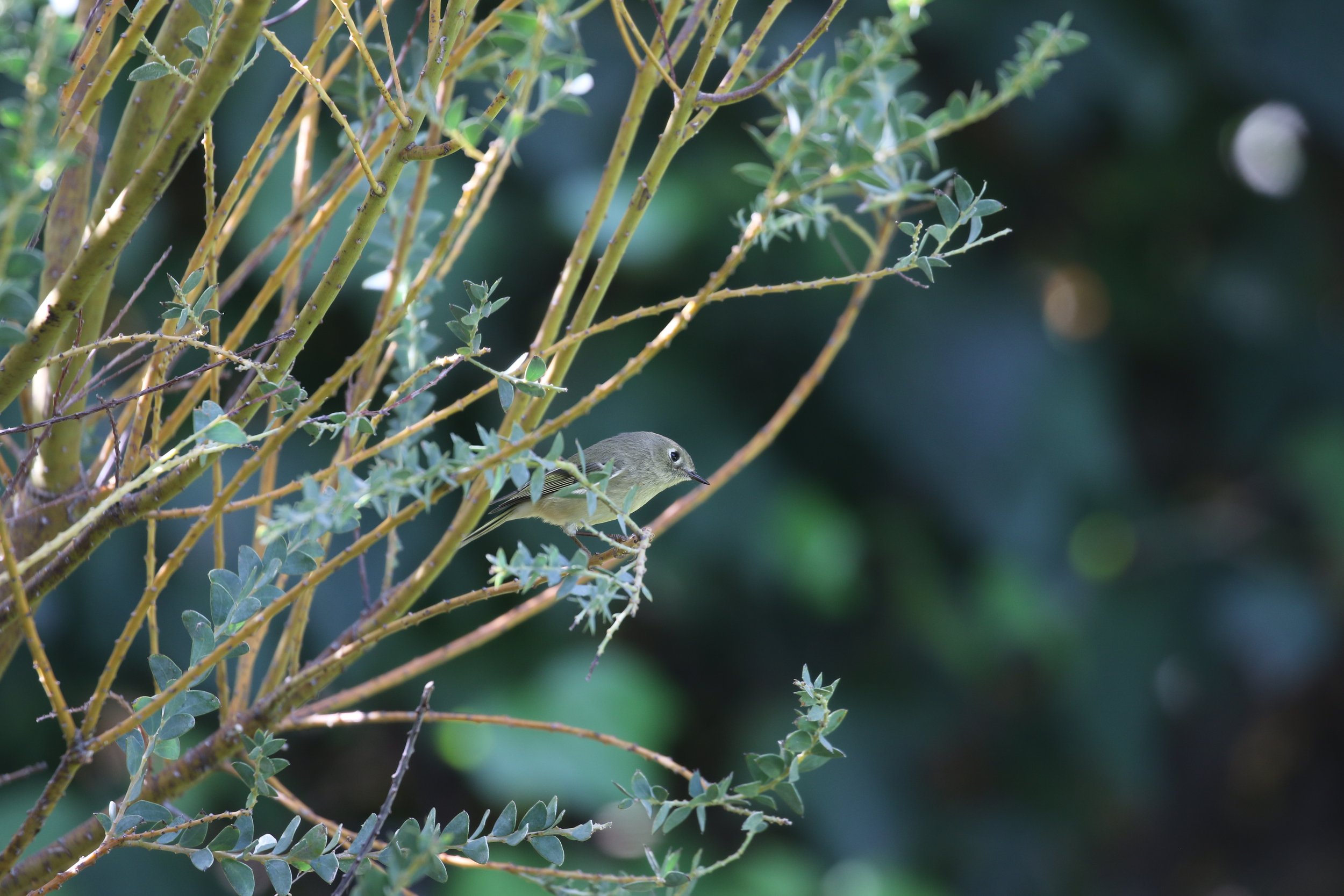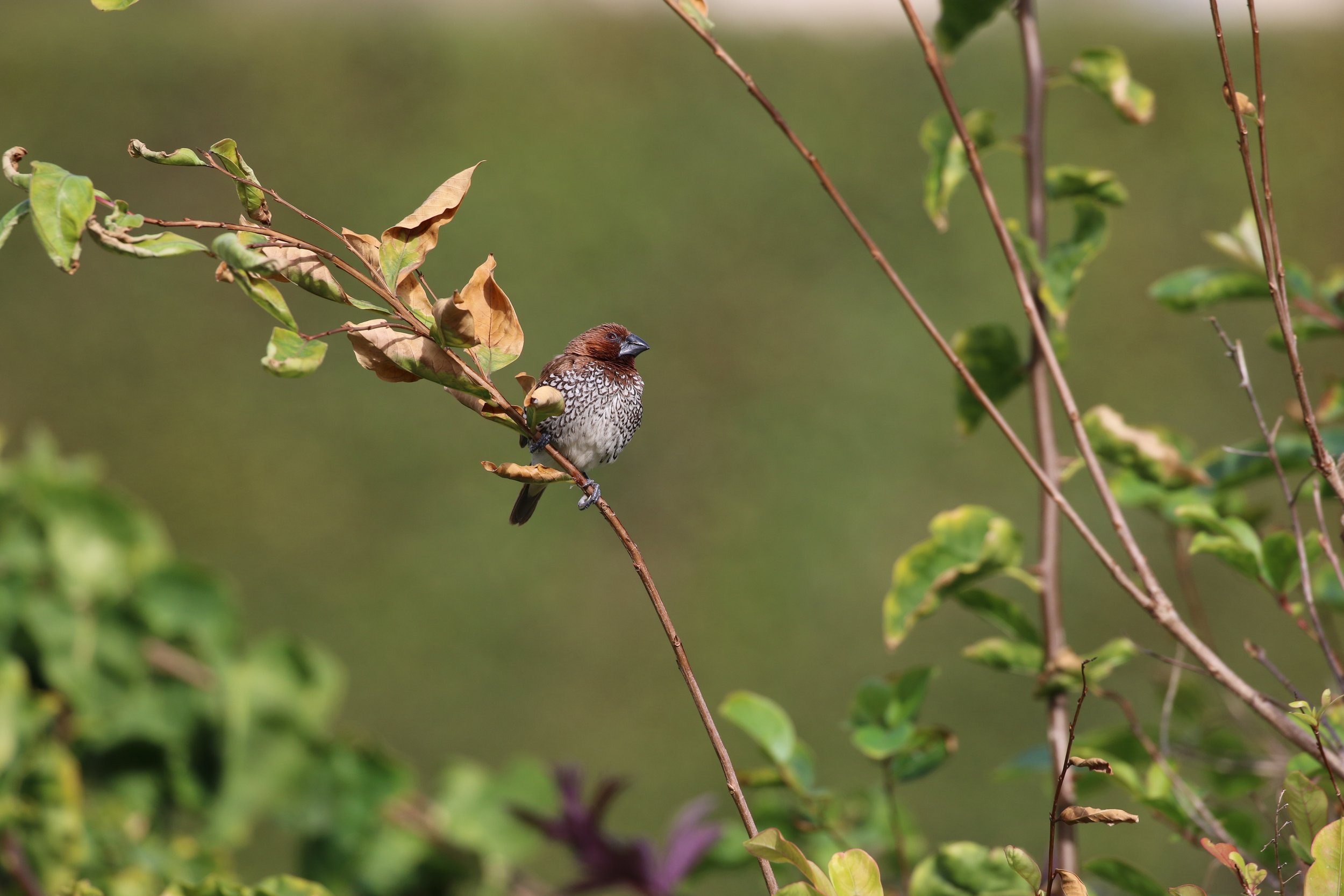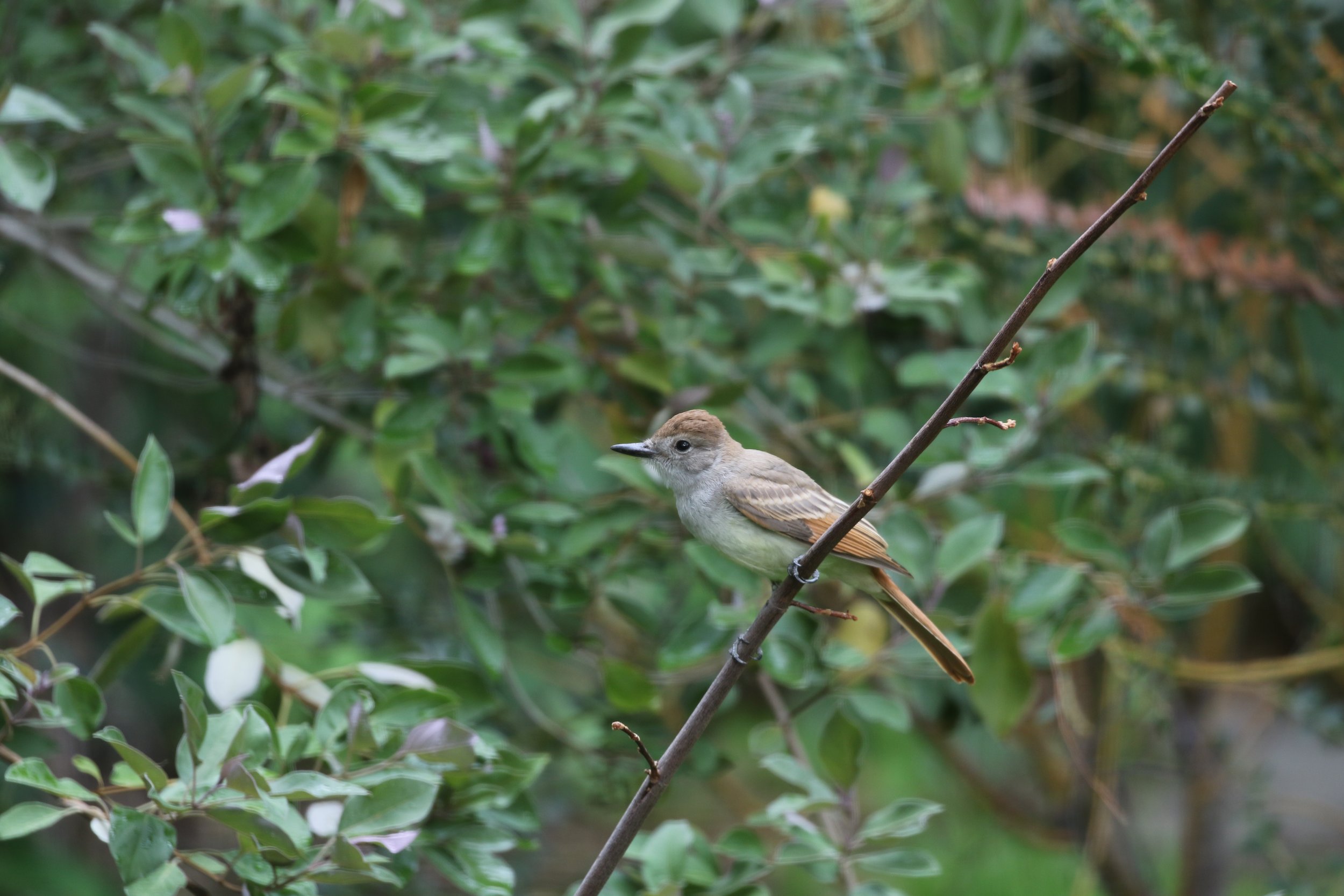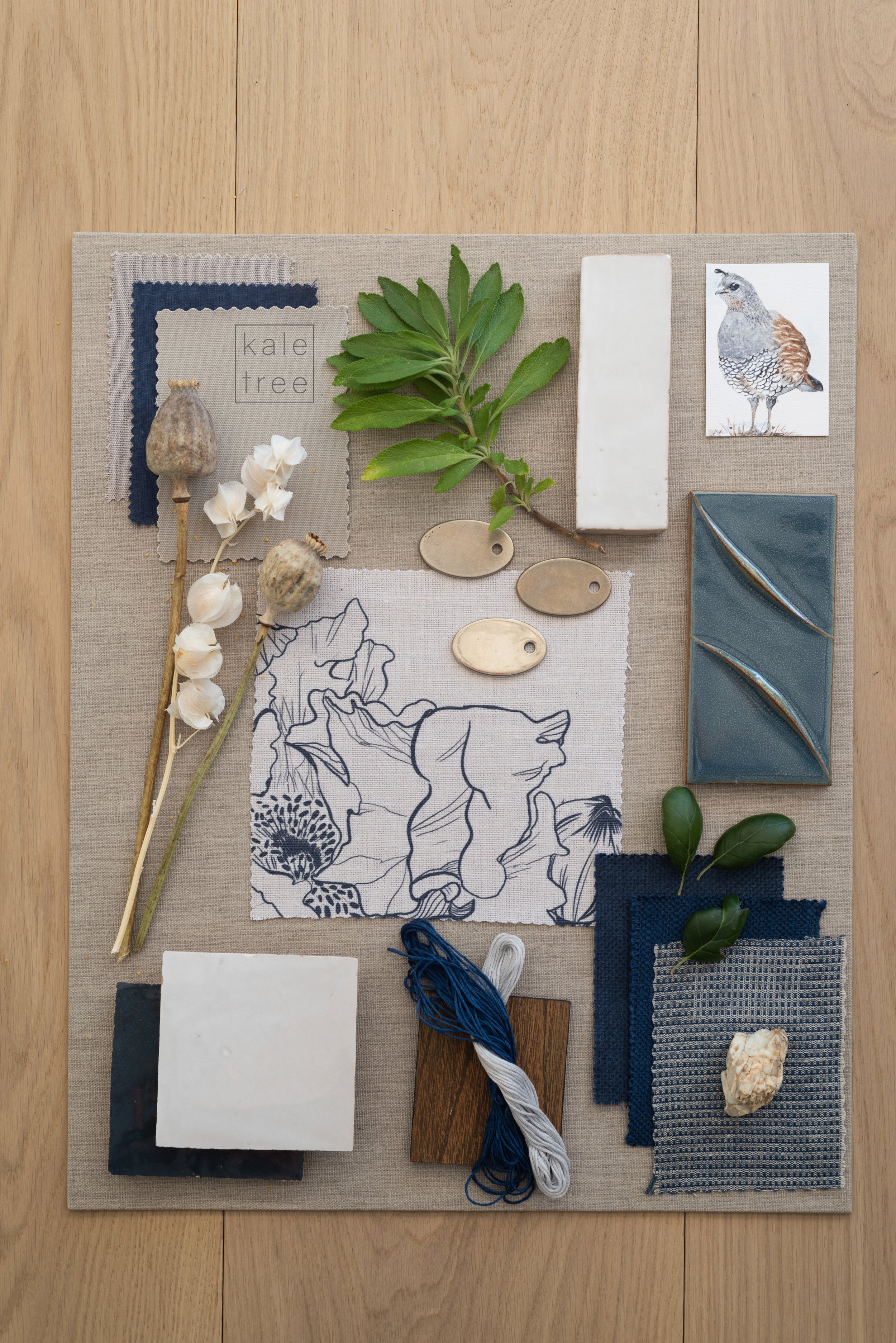Desert Decor: The Unique Appeal of the Cholla Cactus
Cholla Cactus (Cylindropuntia) at Anza Borrego State Park
Southern California is known to house a wide range of natural environments, but none feel as quintessential to the landscape as its vast deserts. Many residents and visitors find solace in the state's desert environments, which host a rich variety of plant and animal life, and provide a stark contrast to more bustling urban city centers. Iconic to these landscapes are the wide variety of succulents and cacti, including the diversity of cholla cacti featured in many state deserts. The most notable collection may be the cholla cactus garden in Joshua tree. However, the plant is interspersed in many desert landscapes, including the shrubbery of Red Rock Canyon and the Mojave Desert.
Cholla Cactus (Cylindropuntia) at Anza Borrego State Park
As a reflection of the unique wildlife beloved in the southern California region, our studio opted to use the cylindropuntia fulgida, or jumping cholla, at the Anza-Borrego Desert State Park as an inspiration for the print on our Cholla Tote. Anza-Borrego houses a cactus garden featuring a wide array of cacti, including several cholla varietals, from the cylindropuntia bigelovii cactaceae (coyly known as teddybear cholla) to cylindropuntia ramosissima, or diamond cholla. The cacti, including cylindropuntia echinocarpa (silver or golden cholla) and cylindropuntia ganderi cactaceae (gander's cholla), bear succulent flowers through the spring, providing a welcome contrast to their spiky texture and barbed spines, which often cling to visitors as unintended souvenirs.
Cholla Cactus (Cylindropuntia) at Anza Borrego State Park
A visit to the state park during a rare super bloom highlighted the surprising yet suitable pairing of soft romantic florals against the less hospitable-looking cacti, encompassing in one plant the variety of nature so unique and beloved to southern California.
Beyond their distinct beauty, Chollas can also serve as a nesting ground for birds like the cactus wren, who use the spikes as a protective barrier from predators, earning an extra layer of appreciation from our avian-adoring studio.
Cactus Wren (Campylorhynchus brunneicapillus)
The design for the tote was carefully hand drawn with emphasis on the plant's ruffled floral edges and spiky barbs, a contrast emphasized with the black and white design. Considerate of environmental impact, the tote bags are produced in small batches using certified organic cotton fabric printed to order and dyed with non-toxic, water-based inks.
A suitable California alternative to spring florals, the tote features an open main compartment, perfect for storing an abundance of farmers market produce, hauling fresh cut florals, or quickly accessing water and well-worn nature journals during desert excursions.
Sarah Barnard, WELL AP + LEED AP, is a leading designer of personalized, sustainable spaces that support mental, physical, and emotional wellbeing. She creates highly personalized, restorative spaces that are deeply connected to art and the preservation of the environment. An advocate for consciousness, inclusivity, and compassion in the creative process, Sarah has appeared in Architectural Digest, Elle Décor, Vogue, HGTV, and many other publications. In 2017 Sarah was honored as a “Ones to Watch” Scholar by the American Society of Interior Designers (ASID).
California Native Gardening: Rewilding Los Angeles Landscaping
California Buckwheat (eriogonum fasciculatum)
With such an array of beautiful and unique plant life, it’s no wonder more and more people are opting to replace their lawns with California native gardens. The state of California is a biodiversity hotspot, with 61% of its plant life found nowhere else in the world. (1) There are many benefits to rewilding our gardens with California native plants. They can reduce our environmental footprint by using less water and creating habitats for local insects and animals, enriching the biodiversity of our local neighborhoods. We also have the pleasure of experiencing the emotional and mental health benefits that result from nurturing this environment and joyfully watching wildlife thrive amongst the beautiful wildflower blooms.
Coulter's Matilija Poppy (Romneya coulteri)
As a Certified California Naturalist, Sarah enjoys expanding her knowledge of Californian native flora and fauna. She recently completed the California Native Plant Landscaper Certificate Program offered by the Theodore Payne Foundation. Developed in partnership with The California Native Plant Society, LADWP, and The US Green Building Council, Los Angeles, this course covers the steps involved in planting and maintaining a California native landscape, such as identifying soil type, choosing plant communities, irrigation, and pruning.
Palmer's Indian Mallow (Abutilon palmeri)
The Theodore Payne Foundation's best practices suggest developing a California native garden as a 4-year process. Although at first, a California native garden will likely require the same amount of water (or possibly more) than a lawn, a California native garden is a long-term investment towards drought tolerance and increasing local biodiversity.
Yerba Santa (Genus Eriodictyon)
Year one involves the initial steps of creating a plant list, mulching, evaluating the runoff potential of a site, sowing wildflowers, and staking young plants. Year two is more about maintaining the garden by raking, pruning, watering, re-mulching, sowing wildflower seeds, weeding, and removing struggling plants. Year three involves seasonal maintenance such as watering, pruning overgrown plants, weeding, and replanting. And year four involves pruning with long-term shaping in mind, weeding, replanting, and watering.
An important course component involves identifying what plants best suit the site based on soil qualities and plant communities. There are generally three soil types, sandy, loamy, and clay which vary in their infiltration rate, water-holding capacity, nutrient-holding capacity, and aeration. Plant communities are groups of plants that typically grow together in natural environments.
California Native gardens usually derive from the following plant communities:
Woolly Bluecurls (Trichostema lanatum)
Coastal Sage Scrub are plants that tend to grow low to the ground; they include many aromatic plants such as Artemisia, Buckwheat, Salvias, and Matilija Poppy as well as Deerweed.
Miner’s Lettuce (Claytonia perfoliata)
Chaparral is thick, dense growth that contains a lot of diversity and tends to burn easily. This group includes Chamise, Scrub Oak, Buckwheat, Matilija Poppy, and Toyon.
Desert is a very diverse community of plants that exist at various elevations, such as Cacti, Joshua trees, Agave, Abutilon-Palmeri (Mallow), and Saltbush.
Cholla Cactus (Genus Clindropuntia)
Riparian is a diverse community of plant species that usually exist streamside, creating vital habitat for California wildlife; this group includes plants such as Jancus, Carex, and Ferns.
California Buckeye (Aesculus californica)
Pruning is commonplace in any garden to shape and control the size of plants, stimulate growth, and improve overall plant health. Folks have very different opinions about pruning a California native garden; some believe the landscape should grow wild and natural, while others regularly prune to control shape and growth.
Tip pinching is often performed in California native gardens; this involves pinching new growth off the tips of certain plants or right after flowering to stimulate fuller growth. For example, Ceanothus is a plant that benefits from tip pinching after flowering.
Bladderpod (Peritoma arborea)
Deadheading is the practice of removing dead flowers from plants before they go to seed, this can improve the appearance of plants and prolong the flowering season for some. Deadheading is sometimes discouraged in California native gardens as birds like to feed on seeds. Allowing plants to go to seed creates a natural food source, plus we get the pleasure of watching wildlife interact with the native plants in our yard. Toyon is an excellent example of this; its flowers bring berries which become food for Robins, Waxwings, Thrushes, and other visiting birds.
California Poppy (Eschscholzia californica)
Embracing a California native garden is a rewarding transformation with many benefits, including eventual drought tolerance, reduced maintenance, and the generation of natural habitat that increases the biodiversity in our neighborhoods. There is also the added benefit of joy we experience through the mindful activity of watching birds, insects, and animals live and thrive in the ecosystem that we have created within our yards.
Works Cited
(1) “Explore the Biodiversity Hotspots.” CEPF, https://www.cepf.net/our-work/biodiversity-hotspots.
(2) Theodore Payne Foundation. “California Native Plant Landscaper Certification.”
Sarah Barnard is a WELL and LEED accredited designer and creator of environments that support mental, physical and emotional wellbeing. She creates highly personalized, restorative spaces that are deeply connected to art and the preservation of the environment. An advocate for consciousness, inclusivity, and compassion in the creative process, Sarah has appeared in Architectural Digest, Elle Décor, Vogue, HGTV and many other publications. In 2017 Sarah was recognized as a "Ones to Watch" Scholar by the American Society of Interior Designers (ASID).
Mule Deer of the Verdugo Woodlands
A California mule deer (Odocoileus hemionus californicus) and fawn.
Humans and deer have lived alongside each other for a long time. In the past, this relationship has been mutually beneficial. Native Californians would routinely carry out small controlled burns to clear underbrush and prepare pastures, which created fresh new growth that deer love to eat. In 1907, the first law to protect deer was introduced in response to the increased interaction between deer and California’s growing population. Laws protecting natural predators such as bears, mountain lions, and wolves took a long time to follow (the endangered species act did not protect bears until 1970), a factor that allowed deer numbers to increase.
Over time, the number of deer that reside in the Wildland Urban Interface (WUI), “the zone of transition between unoccupied land and human development,”(1) and some residential environments has increased. This is perhaps the result of a combination of factors such as; a reduced number of natural predators, the increasing population that lives in or near the WUI, and increased availability of food in well-irrigated environments such as gardens.
As a result, deer have increasingly adapted to live in urbanized environments, and a common issue that arises from living alongside deer is damage to trees and gardens. Deer love to graze on fresh shoots and leafy green plants, which can stunt the growth of young trees and disrupt fruit production. Plants that deer find “highly palatable,” such as roses, apple trees, and members of the Malvaceae family, such as mallow, hibiscus, and abutilon, are also commonly found in domestic gardens.
Cajun hibiscus (Hibiscus rosa-sinensis)
The Verdugo mountains are a beautiful and unique example of the Wildland Urban Interface within Los Angeles. This small mountain range is surrounded by urban development, leaving an isolated pocket of nature within the city. “You have what is almost like a federally protected forest that has survived human urban growth all around it. It’s like an undiscovered Atlantis.”(2) Some neighborhoods that touch the Verdugo mountains include Glendale, Whiting Woods, Oakmont, La Crescenta Highlands, Pasadena, and Altadena. The people who visit and reside here consider it a privilege to live in this unique area where an almost undisturbed natural environment meets the city.
A California mule deer (Odocoileus hemionus californicus) grazing.
As a Certified California Naturalist, Sarah loves exploring the hiking trails in and around the Verdugo mountains. This area is teeming with wildlife “except for the absence of grizzly bears, the wildlife in the Verdugos is much as it was 200 years ago.”(3) California has six subspecies of mule deer (Odocoileus hemionus), The California mule deer (Odocoileus hemionus californicus) is commonly found in the Verdugos and surrounding areas.
One way we can live alongside deer and maintain a beautiful garden is by planting deer-resistant plants, many of which also make a beautiful aesthetic or fragrant addition to our garden. While no plant is one hundred percent deer-proof, there are some qualities of certain vegetation that deer tend to avoid.
Golden Currant (Ribes Aureum)
Prickly or furry plants are a good place to start. Some examples include the Fuchsia flowered gooseberry (Ribes speciosum) and the California barberry (Berberis pinnata). The California barberry’s (Berberis pinnata) prickly leaves make it unpleasant to eat, but it also has beautiful yellow flowers, making it an appealing garden plant. The Fuchsia flowered gooseberry (Ribes speciosum) has gorgeous bright red dangling flowers that also attract hummingbirds to your garden.
Cleveland sage (Salvia clevelandii)
Deer also tend to avoid aromatic plants such as Sages (Salvia sp), Cleveland sage (Salvia clevelandii), and Hummingbird sage (Salvia spathacea) have a beautiful smell that deers dislike.
Tough and leathery plants can be hard for deer to chew. The California bush anemone (Carpenteria californica), a shrub with beautiful white flowers, and the Big berry manzanita (Arctostaphylos glauca) have tough trunks. Ground cover such as Emerald Carpet (A. uva-ursi X nummularia) is a leathery plant that grows densely on the ground, which can also reduce weeds.
California Poppies (Eschscholzia californica)
Fast-growing plants such as the California wild grape (Vitis californica) are a good option, as their rapid rate of growth allows them to recover from being grazed on as they grow out of reach from the deer. Spring wildflowers are also a good option as there are so many of them; even if a few are eaten in amongst all the new growth of the season, plenty still survive to make a beautiful garden.
A California mule deer (Odocoileus hemionus californicus) grazing.
If all else fails, a deer repellent spray can be applied to the plants in your garden. This non-toxic spray (which won’t hurt the deer or the plant) leaves a bad taste in their mouth, which is intended to slow grazing. There is a variety of homemade and store-bought options available.
An Oak Titmouse (Baeolophus inornatus) resting on a water dish.
Taking all of this into account, the remaining wildlife on Earth is a fraction of what it once was, “Extinctions have been a natural part of the planet’s evolutionary history. 99% of the four billion species that have evolved on Earth are now gone.”(4) We treasure day-to-day encounters with the wildlife that remain. Living amongst wildlife in the Wildland Urban Interface is a unique privilege; taking a break from the city and enjoying a hike in this pocket of nature is a wonderful gift. Being mindful of the wildlife in the Verdugo mountains can take the form of gently suggesting not to eat the plants in your garden (through plant choice or other options) or leaving a bowl of water out on hot summer days . This is a rewarding part of the experience of living and visiting here; in return, we get to live alongside these magical animals and watch them thrive.
A California mule deer (Odocoileus hemionus californicus) grazing.
Bibliography
“What Is the Wui?” U.S. Fire Administration, 8 June 2022, https://www.usfa.fema.gov/wui/what-is-the-wui.html.
“A Hidden Mountain Treasure in the City.” Los Angeles Times, Los Angeles Times, 19 May 1998, https://www.latimes.com/archives/la-xpm-1998-may-19-mn-51296-story.html.
“A Hidden Mountain Treasure in the City.” Los Angeles Times, Los Angeles Times, 19 May 1998, https://www.latimes.com/archives/la-xpm-1998-may-19-mn-51296-story.html.
Ritchie, Hannah, et al. “Extinctions.” Our World in Data, 15 Apr. 2021, https://ourworldindata.org/extinctions.
Other Resources
“Mule Deer (Odocoileus Hemionus).” CDFW, https://wildlife.ca.gov/Regions/6/Deer/Natural-History.
Kubey, Elizabeth. “Deer Resistant Native Plants.” California Native Plant Society, 4 Apr. 2018, https://www.cnps.org/gardening/deer-resistant-native-plants-5588.
Sarah Barnard, WELL AP + LEED AP, is a leading designer of personalized, sustainable spaces that support mental, physical, and emotional wellbeing. She creates highly personalized, restorative spaces that are deeply connected to art and the preservation of the environment. An advocate for consciousness, inclusivity, and compassion in the creative process, Sarah has appeared in Architectural Digest, Elle Décor, Vogue, HGTV, and many other publications. In 2017 Sarah was honored as a “Ones to Watch” Scholar by the American Society of Interior Designers (ASID).
Birdwatching as mindfulness: Creative connections within the bird watching community.
The benefits of looking at nature are everywhere, no matter where you live. Outdoor recreational activities such as hiking and being in nature promote feelings of well-being. Recent research by academics at the University of Exeter, the British Trust for Ornithology, and the University of Queensland suggests that birding, in particular, has mental health benefits. Researchers in the UK recently determined that people who saw more birds in their daily lives experience less stress and depression. Bird-watching is a practice that encourages mindfulness and patience. Simply watching a bird feeder can be beneficial for your mental health.
Birding also benefits your mental health through the community and friendships that it creates. A love of birding connects people from all walks of life and is what initially drew interior designer Sarah Barnard, WELL AP + LEED AP, to the artwork of Vivienne Edwards.
The watercolor paintings of small birds included in several of our mood boards for the Matilija Poppy Textile and the Mallow Textile are by the artist Vivienne Edwards. Vivienne is based in South Africa and makes small watercolors of birds that she encounters in the natural environment around her. Sarah discovered Viviennes' work one day by chance, drawn to the intimacy of their small size (2.5 x 3.5 in) and how they reflect the artist's relationship with her natural surroundings.
Sarah is an avid birder and felt that Vivienne's paintings would be a special addition to her art collection. Sarah commissioned a small set of paintings from Vivienne based on photographs Sarah took of favorite birds in her garden.
These magical birds are featured in a series of Kale Tree mood boards, whose nature-inspired luxury eco fabrics incorporate biophilic prints inspired by the intersection of art, design, and nature. Sarah thought these paintings contributed to the overall feeling of these mood boards, which feature a series of natural materials and textures that help visualize the collection of objects that make up an interior space.
The bird featured in this Kale Tree mood board for the Matilija Poppy Textile in Putty is a Ruby-crowned Kinglet (Regulus calendula); this is a tiny, very cautious bird that can be quite timid. Sarah has mainly spotted the Ruby-crowned Kinglet in the Acacia cultriformis tree in her garden, which it uses as a safe passage to the water bowl. It is a fairly solitary bird that does not stay out in the open for too long. Its ruby crown is very subtle, making it difficult for her to identify at first, and she was very happy when she did. The hand-drawn pattern of this floral textile is inspired by Matilija Poppies (Romneya coulteri), a favorite California native flower.
The Hermit Thrush (Catharus guttatus), is a bird with which Sarah feels a real fascination and kinship. Of all the songbirds, the Hermit Thrush is considered to have one of the most beautiful songs. The first time Sarah saw a Hermit Thrush, she was overcome and entranced by the beauty of this bird which felt like it had a magic quality. The Hermit Thrush is quite solitary; it moves along the edges of the garden with cautious stealth, so it feels like a special moment when it is spotted. Hermit Thrushes seldom visit backyards making this sighting and painting all the more special, a beautiful and meaningful addition to the Matilija Poppy Textile (Midnight) mood board from Kale Tree.
The mood board for the Matilija Poppy Textile (Bluestone) features a painting of the California Quail (Callipepla californica), the California state bird. This bird has beautiful feather patterns and enchanting qualities similar to the hermit thrush. Sarah had only ever seen California Quails in the desert until she moved to her new house, where she saw a pair walk across her patio one day. This experience was delightful and magical as it possibly meant they were nesting nearby. Sarah intends to plant a quail bush (Atriplex lentiformis) in her garden to encourage the birds to stay a while.
The painting featured in the mood board for the Matilija Poppy Textile (Natural) is of a Scaly Breasted Munia (Lonchura punctulata). You can usually find this small songbird in grasslands, gardens, and fields; the scaly spots on its underbelly and the color palette of its feathers compliment the stamens in the center of this poppy textile. Sarah first saw this bird in her garden and had never seen a bird like it before. She was surprised to learn that it was an introduced species from South East Asia. On watching this bird, she was struck by how familial and social they are; they are hardly ever seen alone and are often spotted sharing food and space. The Scaly Breasted Munia is also a lot less timid around humans, usually happy to sit and listen to a little bit of a human-to-bird conversation.
A painting of a Bewick's Wren (Thryomanes bewickii) is paired alongside a series of natural materials in the mood board for the Mallow Textile (Evening Mauve). The Bewick's Wren was originally one of Sarahs' favorite birds and has been in Sarahs' life for a long time. At her last house, a mother Bewick's Wren, taught her babies to eat suet cake from her bird feeder. The mother wren would also leave baby birds in a bush in Sarahs' garden while they went to forage, allowing her to spend some time with these usually solitary birds. Although they are usually found in dry bushy areas, the Bewick's Wren is also at home in gardens and parks in suburbs and cities. Its ability to live in natural and built environments creates a lovely allegory reflecting the design philosophy behind this floral fabric.
In this last mood board, a painting of an Ash-throated Flycatcher (Myiarchus cinerascens) accompanies a swatch of the Mallow Textile (Midnight Forest). These birds are often found in dry places, and as a result, they don't need to drink much water. Instead, they get the water they need from their food. Sarah often sees these birds in her garden, but explains that patience is required as they are usually on a perch somewhere, sitting, waiting, and surveying for insects that they catch in mid-flight.
Vivienne Edwards is a self-taught artist from South Africa who loves to work with the unpredictability of watercolors. She is fortunate to live in a wildlife-rich region with abundant bird life and wetlands. Her work takes inspiration from the small creatures in the natural environment around her, going about their daily lives with such purpose and energy. It is often a show of vulnerability from this wildlife that prompts what she decides to paint, such as a Sparrow delicately picking a sprig of parsley for its young.
Sarah and her team love working with other artists, especially those who celebrate the beauty of nature and inspire joy through their work.
Bibliography
“Beautiful Birding: 7 Mental Health Benefits of Bird Watching.” Happiness.com, 27 Jan. 2022, https://www.happiness.com/magazine/art-culture-leisure/mental-health-benefits-of-bird-watching/.
Leahy, Christopher W. “Teaching Your Mind to Fly: The Psychological Benefits of Birdwatching.” Princeton University, The Trustees of Princeton University, 31 July 2021, https://press.princeton.edu/ideas/teaching-your-mind-to-fly-the-psychological-benefits-of-birdwatching.
Ray, Heather. “A Dose of Nature: Why Birding Will Boost Your Mental Health.” Birds and Blooms, Birds and Blooms, 27 Apr. 2022, https://www.birdsandblooms.com/birding/birding-basics/birding-health/#:~:text=Researchers%20in%20Kentucky%20found%20that,beneficial%20to%20your%20psychological%20health.
Sarah Barnard is a WELL and LEED accredited designer and creator of environments that support mental, physical and emotional wellbeing. She creates highly personalized, restorative spaces that are deeply connected to art and the preservation of the environment. An advocate for consciousness, inclusivity, and compassion in the creative process, Sarah has appeared in Architectural Digest, Elle Décor, Vogue, HGTV and many other publications. In 2017 Sarah was recognized as a "Ones to Watch" Scholar by the American Society of Interior Designers (ASID).
Nature at Home: Botanical Textiles from Tradescant & Son Now Available at Kale Tree Shop
Sarah Barnard is now the exclusive California representative for Tradescant & Son through Kale Tree Shop's online marketplace. The line features a wide range of nature-inspired luxury eco fabrics and wallpapers made with a sustainability-minded production process.
Sarah Barnard is now the exclusive California representative for Tradescant & Son through Kale Tree Shop's online marketplace. The line features a wide range of nature-inspired luxury eco fabrics and wallpapers made with a sustainability-minded production process.
The foundation of Sarah Barnard's practice is a belief that interior environments should contribute to wellbeing, both emotionally and globally. Barnard's work focuses on sustainability, emphasizing the importance of nature, both through conscious sourcing and as the inspiration for many of her designs.
The designer's use of natural themes and environmentally conscious materials spoke to the sensibilities and priorities of Tradescant & Son, who recognized Barnard as an ideal representative for their line. Tradescant & Son director Amy Hardman says, "Our 100% linens and the relaxed yet stylish look to our designs promote a holistic and contemporary feel. This, together with the fact that we share a commitment to ensuring sustainability wherever possible by using locally woven fabrics and printers, is a fantastic and exciting foundation for our relationship with Sarah Barnard Design."
The fabrics and wallpapers feature a wide variety of natural themes, from a graphic striped wallpaper composed of vibrant hummingbirds to linen textiles inspired by historic entomology archives from the University of Oxford Museum of Natural History, softly patterned with moths or beetles. With a range of bird fabrics, butterfly patterns, and botanical prints, the timeless patterns nod to historical, scientific illustrations, while their colors and design have a contemporary feel suitable for a diverse array of settings.
On the collaboration, Barnard noted that "As a birder, naturalist, and avid gardener, I was drawn to Tradescant & Son's collection of biophilic prints. Particularly when designing for metropolitan areas, I like to turn to natural motifs to stand in for nature that may not be as readily available for someone with a city view. The entire Tradescant & Son collection offers an impressive array of options when looking to bring the experience of wildlife into an interior."
These products are available for purchase through the website www.kaletree.com. Additional support is available for design and trade professionals by contacting shop@kaletree.com.
Sarah Barnard is a WELL and LEED accredited designer and creator of environments that support mental, physical and emotional wellbeing. She creates highly personalized, restorative spaces that are deeply connected to art and the preservation of the environment. An advocate for consciousness, inclusivity, and compassion in the creative process, Sarah's work has been recognized by Architectural Digest, Elle Décor, Real Simple, HGTV and many other publications. In 2017 Sarah was recognized as a "Ones to Watch" Scholar by the American Society of Interior Designers (ASID).
